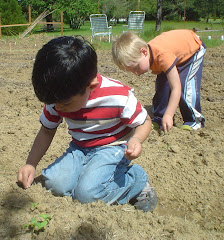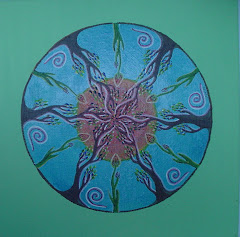The garden is growing exponentially now!
Steve Rose broke ground with his tractor on April 15th, 2009. Here's a picture taken on May 12...

And another on June 13th, of basically the same view, a week ago...

Here's the bean tipi we built and planted on May 22...

And here's a close-up taken June 16, 2009. The beans are really thriving from the rabbit-manure tea we feed them once a week or so. The straw-mulch keeps the soil warm and moist which they like too.

Local Folks Mark Your Calendars: Third Sunday of July, July 19th, 2009 -- 6:30 The Corvallis Chapter of Oregon Tilth is hosting their monthly potluck and garden tour at the Alpine Community Garden. This is a chance to meet other organic gardeners in the area, make connections and share gardening tips. We'll share food together, tour the garden and have a campfire in our new fire-pit! Children welcome. There are picnic tables at the park. you can also bring fold-up lawn-chairs or a picnic blanket.
Gratitude to Margi Willowmoon for the purple potato fingerlings. We've got almost 50 feet of them planted! And to Vicki Thompson for the green pepper and jalapeno starts. We found good homes for all of them. Thanks to any of you who came and picked up tomato starts. They're all gone now. We've got about 80 tomato plants in the garden itself; all different varieties. That oughta keep the Alpine-area real saucy come harvest-time!
Steve Rose broke ground with his tractor on April 15th, 2009. Here's a picture taken on May 12...

And another on June 13th, of basically the same view, a week ago...

Here's the bean tipi we built and planted on May 22...

And here's a close-up taken June 16, 2009. The beans are really thriving from the rabbit-manure tea we feed them once a week or so. The straw-mulch keeps the soil warm and moist which they like too.

Local Folks Mark Your Calendars: Third Sunday of July, July 19th, 2009 -- 6:30 The Corvallis Chapter of Oregon Tilth is hosting their monthly potluck and garden tour at the Alpine Community Garden. This is a chance to meet other organic gardeners in the area, make connections and share gardening tips. We'll share food together, tour the garden and have a campfire in our new fire-pit! Children welcome. There are picnic tables at the park. you can also bring fold-up lawn-chairs or a picnic blanket.
Gratitude to Margi Willowmoon for the purple potato fingerlings. We've got almost 50 feet of them planted! And to Vicki Thompson for the green pepper and jalapeno starts. We found good homes for all of them. Thanks to any of you who came and picked up tomato starts. They're all gone now. We've got about 80 tomato plants in the garden itself; all different varieties. That oughta keep the Alpine-area real saucy come harvest-time!


















































